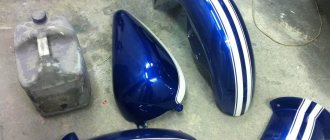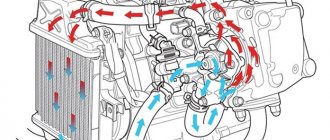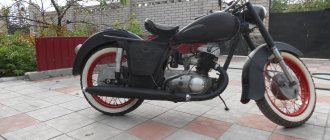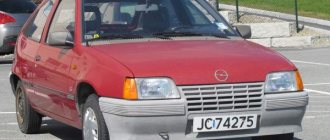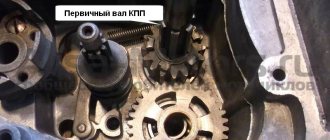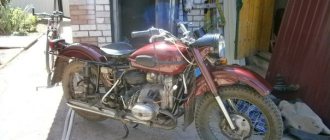Izh Jupiter-2
— a middle-class road motorcycle designed for riding on roads with different surfaces. Produced by the Izhevsk Machine-Building Plant. It was a continuation of the Izh Jupiter motorcycle series and was produced from 1971 to 1971. Then the engineers were faced with the task of making a new motorcycle with a two-cylinder engine. They succeeded.
The motorcycle turned out to be quite powerful (19 hp), the engine capacity of the motorcycle was 347 cm³. The battery was alkaline at 6V.
Izh Jupiter-2 was received well by motorcyclists, but then the opinion changed. The reason for this was the technical problems that arose in operation, in particular, the ignition angle on the motorcycle constantly went wrong over time, due to the negligence of crooked craftsmen who forgot to install engravers. The design of the motorcycle was not entirely successful: the main and glaring mistake of the designers was that on the gas tank, where the Izh badge usually stands, there was a badge with a drawn planet similar to Saturn, but not Jupiter.
| Type | Road | ||||||||||||||||||||||||||||||
| Components | |||||||||||||||||||||||||||||||
| |||||||||||||||||||||||||||||||
| Lubrication system | combined with fuel | ||||||||||||||||||||||||||||||
| Clutch | multi-disc, oil bath | ||||||||||||||||||||||||||||||
| checkpoint |
| ||||||||||||||||||||||||||||||
| Drive unit | roller chain, gear ratio - 2.22 | ||||||||||||||||||||||||||||||
| Fuel supply | by gravity | ||||||||||||||||||||||||||||||
| Front tire | |||||||||||||||||||||||||||||||
| Rear tire | |||||||||||||||||||||||||||||||
| Specifications | |||||||||||||||||||||||||||||||
| Tank capacity | |||||||||||||||||||||||||||||||
| Maximum speed, km/h | |||||||||||||||||||||||||||||||
| Dimensions | |||||||||||||||||||||||||||||||
| Motorcycle base, mm | |||||||||||||||||||||||||||||||
Specifications
- Engine Number of cylinders: 2
- Engine type: petrol
- Number of cycles: 2
- Gas distribution system: piston
- Cooling system: air, ram air flow
- Cylinder diameter: 61.75 mm
- Stroke: 58 mm
- Working volume: 347 cm 3
- Maximum power: 19 hp
- Compression ratio: 6.7-7.0
- Number of carburetors: 1
- Power system: Carburetor K-36ZH
- Engine fuel: a mixture of gasoline and oil in a ratio of 20/1 (during the break-in period) and 25/1 (for a broken-in motorcycle).
- Number of gears: 4
- Front wheel suspension type: conventional telescopic
- Fuel tank: 18
- Battery contact ignition
Tuning a classic model
It's no secret that IZH 2 Jupiter was produced a long time ago. Not many people may like the old, worn-out look of a motorcycle; others want to see something of their own in this bike. There is only one way out - tuning, in simple terms - restructuring. Painting can be considered as one of the low-cost options. New bright colors will breathe a new soul into IZH 2 Jupiter. This will make the bike sparkle in completely new colors. Other craftsmen simply remove the stroller, if available. A lonely motorcycle looks much more impressive.
It is not for nothing that the IZH 2 Jupiter acquired the title of the people's motorcycle. Everything about it speaks of perfection.
Notes
Wikimedia Foundation. 2010.
See what “Izh Jupiter-2” is in other dictionaries:
- This term has other meanings, see Jupiter. Jupiter Superior depicted ... Wikipedia
— “Jupiter and Thetis” (“Jupiter et Thétis”), artist Jean Ingres, 1811, oil, 330×257 cm. This term has other meanings, see ... Wikipedia
— “Jupiter and Thetis” (“Jupiter et Thétis”), artist Jean Ingres, 1811, oil, 330×257 cm. Jupiter (Latin Iuppiter) in ancient Roman mythology, the god of the sky, daylight, thunderstorms, king of the gods, supreme deity Romans Husband of the goddess Juno. Corresponds... ... Wikipedia
- (Jupiter). Roman deity corresponding to the Greek Zeus. He is the king of heaven, on whom all celestial phenomena depend, the ruler of the world, who controls the fate of peoples and states. He was considered the main patron of the Roman state; him... ... Encyclopedia of Mythology
JUPITER (astrological sign G), planet, average distance from the Sun 5.2 a. e. (778.3 million km), sidereal period of revolution 11.9 years, rotation period (cloud layer near the equator) approx. 10 h, equivalent diameter approx. 142,800 km, mass... ... Encyclopedic Dictionary
The motorcycle was a popular vehicle in the USSR, since not everyone had the money to buy a car, and in general there weren’t enough cars for everyone. Back then the motorcycle was accessible and inexpensive. And one of them is IZH Jupiter 2.
The first IZH Jupiter rolled off the assembly line of the Izhevsk Motorcycle Plant in 1961. At first it was given the name IZH-58, but then the boring numbers were replaced with a fashionable space word. Jupiter was at the top of the range of factory products. What a factory one, many motorcyclists considered it the best Soviet motorcycle - powerful and fast.
The second generation model is very similar to the first Jupiters. How is it different? Probably nothing. The crew of the then Izhas was one hundred percent the development of Soviet designers. A tubular frame, a soft telescopic fork, deep mudguards, side glove compartments for all sorts of things - Jupiter inherited all this from the 1-cylinder model almost unchanged.
Izh Jupiter 2 received a completely new, 2-stroke, 2-cylinder, air-cooled short-stroke unit with a volume of 350 cc. and a power of 18 horsepower. The engine is very reliable. Even after 40 years, it comes to life with half a turn and pleases with its characteristic ringing sound.
The engine is very responsive to the throttle. He really has a sporty streak. The first gear is engaged with the clutch, and then, like the Jawa 350, you can shift without squeezing the handle. The acceleration is so vigorous that it takes your breath away! The sofa chair allows you to almost lie down on the tank to accelerate to a maximum speed of 140 km/h.
Motorcycles IZH Jupiter 2 were produced both with and without sidecars. The speed of the solo version was slightly higher than the stroller version. Consumption of 6 liters per hundred was considered economical at that time. The engine is powered by a mixture of gasoline and motor oil. In the 60s and 70s there were columns selling it.
The second Jupiter had a long life. Following the second, the third, fourth and fifth models appeared. Well, then, like all Soviet motorcycles, funds were required to re-equip the plant. No money was found, and that was the end of it. So IZH Jupiter 2 became history.
The city of Izhevsk can rightfully be called the center of Russian motorcycle manufacturing. It was at the local plant that the first five models of motorcycles were produced in a single copy specifically for the participation of the equipment in the second All-Union motorcycle rally. This motorcycle rally began in September one thousand nine hundred and twenty-nine, the total length of the motorcycle rally route was almost three and a half thousand kilometers. Each of the motorcycle models produced by the Izhevsk plant successfully completed its task.
As for motorcycle models, the production of which was massive, the most popular of them has always been and remains to this day the Izh Jupiter 2 motorcycle.
General description of the motorcycle IZH Jupiter 2
The design of the IZH Jupiter 2 motorcycle is made in a classic style and in terms of appearance is practically no different from the vast majority of other domestic motorcycles produced in the same years. The wheel length of this motorcycle model is two hundred and thirteen centimeters, ground clearance is thirteen and a half centimeters, and the wheelbase is one hundred forty-three centimeters. This motorcycle model weighs one hundred eighty-five kilograms.
Motorcycle brand Izh Jupiter 2
is a double room. Its main distinguishing feature is the presence of a special tubular frame. Its wheels are covered with special narrow metal wings.
As for the fuel tank of this motorcycle model, it is standard and can hold eighteen liters. In the Izh Jupiter 2K version, this motorcycle model may also come with a sidecar. In this case, the motorcycle will no longer weigh one hundred eighty-five kilograms, but two hundred and fifty-three kilograms. At the same time, its passenger capacity will increase to three people.
Characteristics and design features of the motorcycle
This motorcycle model has an excellent ride both on highways and on country roads. In addition, its advantages include relative ease of operation.
Despite the fact that this motorcycle model has a sufficient degree of reliability, it has one significant drawback, which is that the ignition angle is very often confused. This happens mainly due to the fact that motorcycle owners forget to install the so-called engraver.
It is also necessary to note a significant omission by the designers of this motorcycle model, which is that the emblem on the fuel tank is more reminiscent of Saturn rather than Jupiter.
This motorcycle model is equipped with a special two-cylinder, two-stroke power unit with an air cooling system. Its working volume is three hundred and forty-seven cubic meters.
The engine power of this motorcycle model reaches nineteen horsepower, which, in turn, allows the motorcycle to reach speeds of up to one hundred and ten kilometers per hour. In the case of the Izh Jupiter 2K version, the maximum speed is eighty-seven km per hour.
The front wheel drive is chain driven. The transmission is four-speed.
Among other things, this motorcycle model is equipped with a special telescopic suspension, which is also called a fork, on the front side and a pendulum-type suspension with several shock absorbers on the rear side. As for the wheel suspension of the stroller, it is torsion bar.
The operation of the standard electrical equipment of the bike is ensured by a special alkaline battery brand ZMT-6, which supplies voltage with a power level of six volts.
The front brakes, as well as the rear brakes of this motorcycle model, are drum brakes.
With this configuration, this motorcycle model consumes about 6 liters of fuel for every hundred kilometers traveled.
Motorcycle history
The first prototype of a motorcycle called “IZH JUPITER” was demonstrated to the general public in the city of Brussels in one thousand nine hundred and fifty-seven as part of the annual world motorcycle exhibition. And by the end of one thousand nine hundred and fifty-eight, mass production of this motorcycle model was launched.
This motorcycle model was based on the IZH-56, but was equipped with an updated two-cylinder power unit, produced at a mechanical plant in the city of Izhevsk. During the development process, this motorcycle model was called “IZH-58”. And only with the start of mass production in one thousand nine hundred and sixty-one it received the name “IZH JUPITER”. The second generation IZH JUPITER was designed specifically for driving on roads with a wide variety of surfaces. Compared to the IZH JUPITER model of the first generation, the second generation IZH JUPITER model was distinguished by an increased power level of the power unit, as well as aluminum wheel hubs and pads.
Currently, purchase a motorcycle model IZH Jupiter 2
quite problematic, because its mass production was discontinued in one thousand nine hundred and seventy-one.
Video review of the IZH Jupiter 2 motorcycle
] In my childhood in the 90s, when most people didn’t have computers and spent their free time on the street, the time came when owners of mopeds first appeared in the yard. mostly holes with pedals, less often in the Carpathians and Riga. A year or two later they already arrived at the yard in Voskhody, Minsk, Izhakh, most often without documents and without category “A” licenses. Owning a Java, and even more so the latest model at that time, was the height of cool. But most of my peers, 14-16 years old, moved on two wheels with pedals and a drive on two legs, envying the guys in helmets. A boy of those years could not have a motorcycle for several reasons: 1. Parents do not allow it. (and they do it right). 2. No money (it’s the 90s). 3. He doesn’t need to do this himself, he doesn’t know how and in general it’s better to do his homework :). My option was point No. 2. When the desire to own a two-wheeled vehicle overpowered all possible boundaries, my brain began to think about how to make money on it. There are not many options at 15 years old. He dragged corn from the fields, boiled it and sold it at the market. I saved up 800 rubles in a month! As a result, the next year, in the spring, I bought an IZH Jupiter 2 with a stroller for 600 rubles from an advertisement. and gave 100 rubles for a general power of attorney. Photo from 1999. Here I am 16 years old.
What a time it was! Gasoline cost 3-4 rubles a liter, and there was also no more than 10 rubles in my pocket. After some time, he unhooked the cradle, drove the motorcycle to the dacha and spent the whole summer and autumn riding it. In winter, I decided to make it a cool sports bike, black and red, with a fire on the tank, with a raised wing. It’s not hard to guess what came of it, and after a year of being idle in the garage, it was sent to the village, where it was revived and exchanged for grain. Time passed, but the thought of buying an IZH Jupiter 2, restoring it and driving around remembering my childhood never left me. Studying, the army, marriage, work, a small child, work and business trips again, did not give thoughts and a chance for a motorcycle and free time around it. Finally, approaching 30 years old, when my capabilities became a little closer to my desires, I sat down on the Internet in search of Jupiter 2 in decent condition and configuration. But that was not the case, for everything more or less alive and intact, the owners asked for the amount that appeared in their heads, apparently after a strong blow, citing the fact that this was already a rarity and its place was in a museum, and not as it is now near a special... barn .
Once I pushed my grandparents to the side of the road (I did it very politely). I say, “Father sell the motorcycle, I will restore it and keep it.” Grandfather - “What are you planning to restore in it? It’s already in good condition and is generally intact.” - “Well, I’ll paint it... sell it and buy yourself a modern Jupiter.” - “I don’t need a modern one, I’ve been on this all my life. If I die, then I’ll sell it” - “How will I know that you’re dead?” - “I remember your numbers, he says, they will tell you.” Grandfather got caught with humor and parted ways. Such people do not sell their friend; their children and grandchildren do it for them afterwards. Either the price tag is for a rarity, or for scrap metal after being rolled up.
Months passed, and evening viewing of advertisements for the sale of motorcycles became a habit. And then one day it comes across - IZH Jupiter 2 is for sale, price 10 thousand rubles. The photo shows a completely complete motorcycle with good chrome. There was one thing, three weeks earlier I bought an IZH-49, around which all my free time revolved. My wife looked at the ad and said, go and pick it up, then you’ll regret it, we’ll go together. For this I thank her very much, for her understanding and full support in my hobby.
Having arrived at the place, I discovered that the motorcycle was assembled on a non-original frame, the right glove compartment was from the third series. The price dropped to 6 thousand rubles and I happily took it home. It was winter, but it was impossible not to drive, especially since it started up perfectly. All the lighting equipment worked, right down to the signal.
In the photo I am 30 years old. Find 10 differences from the photo above))))
The motorcycle sat for a year, the IZH-49 was occupied all the time... Finally, I decided to disassemble it. I already had experience on how to make fewer “unnecessary movements.” I was planning on taking it to a sandblaster and painting it in a powder booth. To order, I selected a beautiful milky beige powder color, with gloss, and took black for the frame and chassis parts, in order to break up the monotony.
Unfortunately, everything didn’t turn out the way I wanted. The beige powder paint turned out to be of poor quality. The result was a matte yellow color, while the black one lay down well and correctly. I had to manually clean off the powder paint again and prepare it for regular painting with cheap auto enamel, for drying in a chamber.
I was hoping to find remnants of chrome under the layer of dirt and oil, but the shiny surface of the exhaust pipes is bare metal that has been cleaned to a shine. Until I found a donor, I decided to paint them the color of the motorcycle. They shouldn’t burn; early IZhs were painted entirely at the factory.
After painting. I chose blue color. There are no documents for it, so I didn’t get attached to the beige one, which I didn’t really like
Quotes! Electrical tape from the first experience with IZH-49 in the firebox! You need masking tape. Automotive masking tape ZM costs 200 rubles for 5 meters, but you need 20. I found it in a hardware store, it’s rough, thick, but an alternative price - for 40 rubles. I bought a very good paint, the color of it really gives off chrome, not silver.
The Soviet motorcycle industry was diverse and replete with various models of motorcycles. The IZH motorcycle brand was produced from 1929 to 2008. The plant where they were created was located in the glorious and old city of Izhevsk. And one of the most popular motorcycles in the USSR was the IZH-2 “Jupiter”. Let's take a closer look at this model.
Assembly, painting, installation of a forced engine
At the moment, the engine had already been assembled a long time ago (summer 2019) and in the fall of the same year it successfully burned the piston all the way through. I’m writing to the magazine purely so that it might happen that someone here reads it and thinks that the project has been abandoned. No! it's finished and brought me a lot of emotion last season. I just found the time and decided to write all this. I won’t describe everything in too much detail, everything is in the pictures, if you have any questions, ask VK.
The spacers are glued together from 3 pieces with sealant, everything was turned by hand with a drill. gluing was done something like this: I spread sealant between them and tightened the cylinders; after some time after hardening, the cylinders were removed and the squeezed-out sealant was removed.
At the same time, the steps were removed from the assembly (without the crankshaft), the channels are smooth to the touch and no steps are felt - that’s enough.
the bearing and oil seal are swapped - there is a need for an additional lubrication channel. The wall is not very thick and cannot be cut too much. I didn’t measure the depth and width, but I think this should be enough
In order for this channel to be useful, I had to make a new groove for the retaining ring! its location is not difficult to determine - you need to assemble the assembly on the dead crankshaft and bearing, not forgetting to put the spacer washer on this side, with the bearing and cover. After all the shenanigans, remove the crankshaft so that the bearing remains. Next, we take a wide cutting wheel for the drill, rest against the bearing and sharpen the groove until the ring begins to fit into it normally. it turned out something like this:
the journal on which the bearing used to be was polished with a rubber-abrasive nozzle. it turned out very smoothly
Unfortunately, the stainless steel screws turned out to be a bit of crap, but they still managed to tighten well, I put everything on the blue lock.
The length of the screws is 3 cm, the thread had to be cut to the end.
with the right side of the boat everything is as usual, nothing fancy. flywheel 1536
and voila, the bottom is assembled
I also made the slots with a cutting wheel for a drill
The spacers are also glued into the crankcase, as a result there is only one opening left for the gasket without sealant so that it does not squeeze out. the holes in the pistons are cut out with a drill, so that both rigidity and efficiency are optimal
There were no rubber rings, I applied sealant. spacers and gaskets were calculated so that the so-called leakage was the same on each cylinder
cpg fully assembled
the intake is fully installed, I won’t describe intimate details
and here is another problem with dropsy that you may encounter.
I made an approach with a drill (I don’t remember which one) so that the screws under the internal screw would sit inside like this, the main thing is not to overdo it. The adapter fitting itself was also sawed off from below.
I won’t describe the ignition, clutch, everything is as usual. The first launch was successful, I liked everything, but I wanted to play around longer, there was only gasoline in the carbs. It didn't work the first time because... the engine is not on the frame, I had to put my knees down and call an assistant to hold it, stamp it a couple of times - and that’s it, everything is clear! started up, worked, revved it up, loved it! The response to the gas is playful, but it didn’t bother me too much, it’s not possible yet, the main thing is that it works and I managed to set the idle. This means everything is assembled at least hermetically.
Next comes painting.
dual-circuit cooling system
OK it's all over Now.
then normal adapters from RD350 arrived
absolutely clear in general, everything is the way I wanted.
The standard air intake served well as an adapter for Minsk filters.
and how it all drives is not comparable to stock at all, I immediately overtake the Priora by 3 car lengths up to 120 km/h, and then, for obvious reasons, the car catches up. The star is set to 18. The bottoms are fine, they are there, all the alterations did not particularly affect the quiet ride. but you no longer want to drive quietly when you know that you can pile on.
Attached videos:
Motorcycle characteristics
This motorcycle was first released in 1965 under the engineering name IZH Jupiter-2. The characteristics are impressive for that time. The two-stroke engine has one cylinder with a volume of 350 cm³. Power is 20 horsepower. Cooling is carried out by air flow, and the engine is lubricated with a mixture of oil and fuel.
The motorcycle weighed a lot - 165 kg. And if you couldn’t be called a weightlifter, then you had to think several times before purchasing it. But it is worth noting that the IZH Jupiter-2 motorcycle was excellent for long journeys, because the maximum weight load on the trunk was 20 kg, in addition, two people could ride on it. But unfortunately, its fuel consumption, by modern standards, was high - 5 liters, when driving at 90 kilometers per hour.
But if you still decide to buy this legendary motorcycle, then you will have to ask yourself one problem: to find AI-76 fuel mixed with oil in proportions of 1:25 at the gas station (where one part is motor oil).
"IZH Jupiter-2" - characteristics
All the bells and whistles, the looks, the innovative details don't really matter. The only thing you should pay close attention to is the technical specifications. They can tell you about the bike what the shine hides. And so, the main center of any vehicle, and a motorcycle is one of them, is the engine. Therefore, the first thing you need to look at is the motor. IZH 2 Jupiter has a gasoline power unit, which is classified as a two-stroke system. This means that the pistons are lubricated by supplying the main fuel. That is, right at the gas station, in addition to gasoline, engine oil must also be poured into the fuel tank. At first glance there are a lot of details, but once you get used to it, you don’t notice it. The Jupiter engine has only two cylinders.
Their total volume is three hundred and forty-seven cubic centimeters. The IZh engine is capable of developing a power of nineteen horsepower. This is normal for a light motorcycle. The good old carburetor is responsible for supplying fuel. You should not forget the main thing: practical characteristics. “IZH 2 Jupiter” on relatively flat terrain is capable of reaching a speed of one hundred and ten kilometers per hour. Fuel consumption is low: four and a half liters of “eightie” per hundred kilometers of working distance. Jupiter is cooled using air currents. Not very effective, of course. But it was relevant for that time.
Motorcycle design
IZH "Jupiter-2" has a tubular frame and a soft front shock absorber, which allows you to move over rough terrain without serious problems. Also pleasing are the wide mudguards, a glove compartment for tools needed by the driver, and drum brakes.
Most of the parts of this vehicle were inherited from the first Jupiter, so it is extremely difficult to distinguish them. The only difference is that the second model has a two-stroke engine.
The engine allowed the motorcycle to accelerate to 110 kilometers per hour, which was an amazing speed for that time. Fuel was supplied to the engine by gravity, and the drive was carried out by a chain of rollers. The tank volume was 18 liters.
Novelty, or What the second “Jupiter” gave the world
The motorcycle differed little from its predecessors. Although there were technical and design differences. The new design is a separate topic, but the appearance of the model has been radically redesigned. Now “IZH Jupiter-2” began to look different. The electrical power supply circuit has also undergone modernization. New lighting required new wiring. By the way, about her.
There are few warning lights on a motorcycle. There is only a front round high beam headlight and a rear electric reflector. But by today's standards this is not enough. Therefore, modern motorcyclists riding a Jupiter are required by law to use side turn signals. The engine was also rebuilt.
History of IZH-2 "Jupiter"
At the end of 1958, the State Planning Committee issued an order for designers to create a motorcycle for riding on all types of road surfaces. At that time, not everyone could afford a car, but transport was necessary for the proletariat. And the State Planning Committee decided to begin mass production of a motorcycle that could travel on country roads. There was no prototype for this IL model, so everything was created from scratch.
The first motorcycle IZH-2 "Jupiter" was created had good characteristics. In addition to the characteristics listed above, the motorcycle had a lead-acid battery with a voltage of 6 V. During testing of the model, the gearbox was improved and the clutch was adjusted. Some time later, mass production of this model began.
Motorcycle type
“IZH 2 Jupiter”, like many of its “friends”, belongs to the type of classic motorcycles. What is characteristic of him? Firstly, the main distinguishing feature of each “classic” is the straight fit. The seat is not moved back, not set low, it is level. This seat promotes a pleasant ride.
On a long road, in order not to get tired, you need to keep your back straight, only a classic motorcycle is capable of this. The pedals are not thrown forward. They are tucked under the driver. Thus, when supported, a right angle is formed. This doesn’t make your legs go numb, which is very important. The low steering wheel makes handling better. You don't have to reach far to grab the horns. The classic motorcycle feels good both on good roads and in poor surface conditions.
Side-trailer version of the motorcycle
A sidecar or so-called cradle on a motorcycle provided a replacement for a car. The trailer could carry both one passenger and cargo, which is why this vehicle was quite popular in the Soviet Union. The model also had a rear compartment for a spare wheel.
By the way, some “home-made” from the Soviet Union saved on purchases and made cradles for their “Jupiters” from small beams and sheets of metal profiles, as well as from wooden boards.
It must be said that motorcycles with sidecars were used by the police until the beginning of the 21st century. They were equipped with liquid cooling, telescopic front forks and disc brakes instead of the usual drum brakes. They also had built-in radios and protective glass.
For public service, motorcycles from Izhevsky and Junker were usually converted. Nowadays, police officers patrol their areas in German BMWs. Strollers for the IZH “Jupiter-2” have become a rarity (you can see photos of them in our article).
- The motorcycle was first created by the German designer Gottlieb Deimer. He received a patent for it on September 29, 1885.
- Do you think airbags are only installed on cars? No, you are extremely mistaken! The airbags were first used on Honda motorcycles.
- In the twentieth century, motorcycle races were organized on the streets of residential areas. After several tragic consequences with pedestrians and racers, “high-speed chases” began to take place on specialized tracks.
- The USSR was one of the countries where motorcycles were produced in large quantities. In the world rankings, the Soviet Union took second place in this, losing to Japan.
- Actor Brad Pitt is seriously interested in collecting motorcycles. In his collection there is a motorcycle of our production - “Ural Tourist”. It is noted that the actor likes to go on motorcycle rides on this motorcycle.
- Few people know that to purchase a heavy motorcycle in Japan, you need to pass a strength test. It includes one test - raising the motorcycle from a recumbent position.
- Ernesto Che Guevara was a motorcycle enthusiast. He published the book “The Diaries of a Motorcycle Rider,” where he described his motorcycle travels.
"IZH Jupiter-2" - the photo will not deceive
The design of the bike is quite good for the sixties. IZH Jupiter-2 looks good. The photo cannot fully convey all the colors of the motorcycle. Large chrome exhaust pipes that run parallel to the ground immediately attract attention. A neat classic frame, there is nothing superfluous on it. The wheels are set shallowly in the wheel arches.
The compact engine, which can be seen in the middle of this picture, does not protrude from the sides. It’s worth saying a little more about the fuel tank. The teardrop shape looks as great as ever. Among the notable details are the round speedometer and the constant “Jupiter” inscription. Next to it is a picture of the planet itself.


